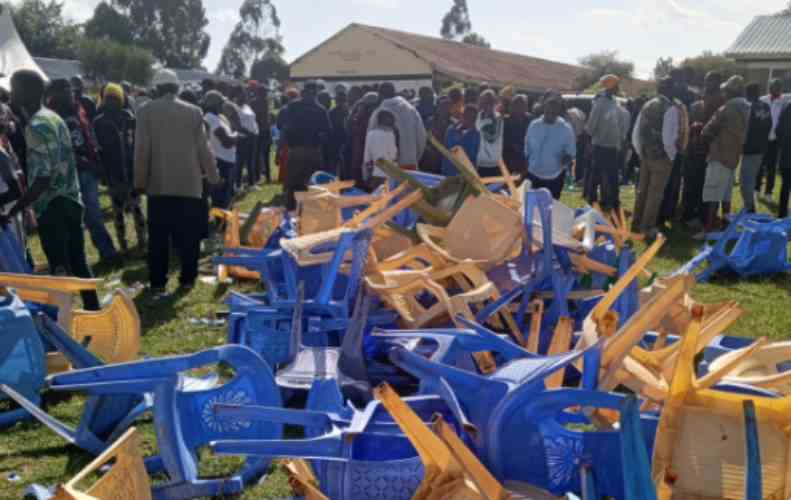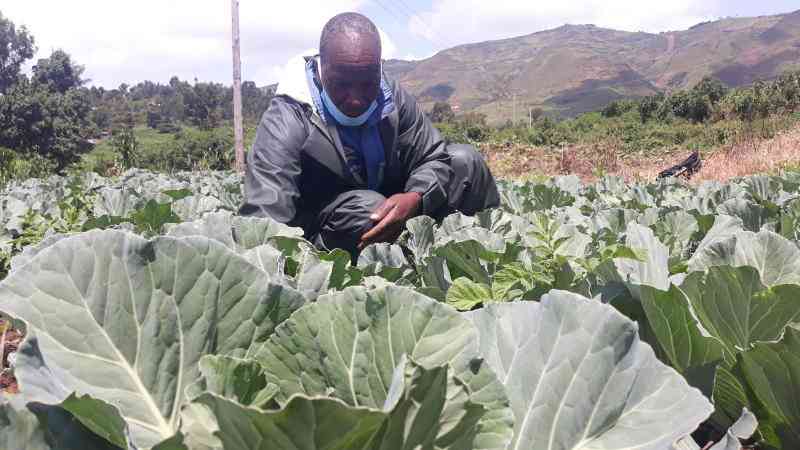Endarasha Location, perched on the massive shoulders of the Aberdares in Nyeri County, is a fertile region where just about anything - cabbages, onions, carrots and potatoes - flourishes in a good season.
The Aberdares sits across Mt Kenya, both landmarks responsible for the bouts of relief rainfall that have hit the region. But this year has been different. The torrential rains, which at the beginning were welcome, have led to massive destruction, with farmers ruing their bad luck.
Dairy farmer
John Wanyeki, a mixed crop and dairy farmer, walks me around his farm, a one-acre piece of land where he has planted onions as a cash crop alongside other basic subsistence crops. Some of the onions are ready for harvesting, the second lot is just about developing bulbs while the third was planted barely weeks ago. Beside them, in immaculately designed nurseries, are onion seedlings which will be replanted in the near future.
In spite of the area’s proximity to the Aberdares and Mt Kenya, rainfall is mostly rare and always unpredictable. Mr Wanyeki has, thus, laid out a system of drips that feed his onions when the rains fail. He has done this for two years now.
“Water is the main impediment to successful farming here,” he says, as we amble towards his 80,000 litre tank. He tells me that he is a member of a local water project which supplies water four times every month. The water that flows in every week, he estimates, is around 20,000 litres. He then directs it to the pipes for his drip irrigation project, but he feels it is never enough, and that’s why he ensures his onions are planted at different times of the year to optimise on the use of the available water. “If all of the onions were in their infant stages, the water would barely be enough,” he says.
A National Irrigation Board project has seen multiple, vast water reservoirs dug in the area, something some locals are skeptical about. Each of the reservoirs is around 1,000 cubic metres. Mr Wanyeki, however, feels that the ward leaderships’ intentions in the push for the digging of the dams were pure and healthy, citing lack of dam liners as the only problem. Wanyeki leads me to a nearby waterhole which is full to the brim, and I can see the protruding dam liner.
“It cost them Sh130,000 to insert it. If the county government can do this for us as well, we will lose very little water to evaporation and infiltration when the dry season kicks in. But it will be an expensive project; we cannot tell how soon that can happen.”
Gataragwa Ward member of the county assembly Clement Warutere explains the process of sinking boreholes has been unsuccessful so far, but that they will not give up just yet, having only managed to drill one in several attempts.
Like many people in Endarasha, Mr Wanyeki believes that onion farmers in the region are neglected. There are no Saccos that would lend money to the farmers, access to government-provided fertilisers is difficult, onion seeds’ prices keep on escalating and, at the time farmers sell their produce, the prices are extremely low.
“A 500g sachet of F1 Hybrid Onion Russet seeds goes for Sh11,500. To imagine that I bought the same sachet of seeds for Sh3,000 just over 10 years ago is nauseating,” he says. In addition, pests such as thrips are common and the onions need constant spraying to keep the insects at bay. The pesticides are expensive, and farmers barely have people to instruct them on which specific pesticides to use. Marketing agencies, or pesticide manufacturers, will promote their products, even when it is not the best option for the farmers. This misdirection affects production.
Bernard Maina has been the chairman of Gitegi Commercial Village for 10 years. He is also an onion farmer and currently has a two-acre onion plantation. He has an acre of wheat, but wheat doesn’t require as much water, or attention, as onions. His 10,000-litre tank, he laments, is barely enough for his two acres and he has to depend on the unpredictable rainfall.
In his 10 years at the helm of the local commercial body, Mr Maina has interacted with tens of Non-Governmental Organisations that are interested in onion, and other locally grown cash crops. These organisations advise locals on best farming practices, present them with opportunities to learn more about farming by organising shows, namely visits to well-established agricultural farms and shows, and also offer farming equipment to the farmers on loan.
Maina, just like Wanyeki, bemoans the pathetic state of roads, most of the feeder roads turning into impassable muddy brooks when the rains come.
“We cannot transport our produce to the market in good time. Most of what we harvest ends up rotting in makeshift storage places. Some of the onions rot in the farms and we can do nothing about it. You have nowhere to store them even if you would harvest.”
Stay informed. Subscribe to our newsletter
Joshua Mwangi, a small-scale farmer, has ditched onion farming this season, opting to go for cabbage, pumpkin and capsicum. However, unavailability of reliable supply of water greatly hampers production, with onions, in particular, famous for their notorious affinity for water. He has been an onion farmer for over two decades.
Impassable roads encourage middlemen and hawkers who use boda boda to collect onions from farmers even in the most inaccessible of areas before transporting the product to the nearest Kiawara market, over 10 kilometres away. Desperate farmers, who would rather sell their produce at throwaway prices than see it rot, end up getting exploited. The farmers sink deeper into poverty as middlemen reap huge, unwarranted profits.
Mr Mwangi also reveals that dependence on rainfall, which falls in April (long rains) means that every planting activity happens at the same time, meaning that harvesting also occurs at around the same time. The surplus in supply leads to a plummet in prices of produces, leading to farmers incurring heavy losses.
Wanyeki decries the random and well-known habit of brokers to use broken spring-balances to con unsuspecting farmers. A season ago, in the neighbourhood, he witnessed a large-scale farmer sell his onion produce to a company that used a digital weighing scale. He describes the experience as eye-opening, citing high accuracy of the machine, thus incredible reliability of figures read.
“If the machine is regularly calibrated, there’s little chance for error. And, see, if there is a standard scale for everyone, then it is level playground.”
Eleven years ago, locals started Nganyuthe Water Project. So many people joined the bandwagon, hoping to eliminate, once and for all, the bug of water shortage that has been for eons responsible for low crop production. With an initial budget of Sh14 million, they set to work. As of 2019, reliable sources indicate that the figure has been blown up to almost Sh19 million, and the water has not reached any tap. A Sh2.5 million expenditure was lumped on the construction of the intake, which soon after collapsed after a torrential downpour. The project continues to portray the face of a potential pipe dream, even as more money is pumped in and pipes piled up awaiting action.
Wanyeki, as does Maina, practices dairy farming. He keeps two cows which supply his household with enough milk. The excess is sold to brokers who in turn sell to processors. Last year, he kept 126 chickens, all of which he has since, painfully, sold.
“When you go to sell your eggs, maybe Sh15 an egg to realise a little profit, you find that there are crates upon crates of eggs from abroad, with each egg going for Sh8. With all the expenses on feeds and transport, you cannot compete in such an unfair market. It looks like a case of economic sabotage by our government.”
Farming onions
While many people have resorted to farming onions, the most potent cash crop in the region, others have settled for dairy farming, with some making it their predominant trade while others juggle between it and crop farming. Still, Endarasha Farmers Cooperative Society still manages to collect around 10,000 litres of milk every day, having a membership of 2,100. This time last year, the membership was at around 1,800. This is a 17 per cent increase in membership.
Endarasha Farmers Cooperative Society has laid out plans to buy its own processing machines in the near future.
As population increases in the area, what used to be huge, unused expanses of lush grass have been sliced into small pieces of plots for settlement.
 The Standard Group Plc is a
multi-media organization with investments in media platforms spanning newspaper
print operations, television, radio broadcasting, digital and online services. The
Standard Group is recognized as a leading multi-media house in Kenya with a key
influence in matters of national and international interest.
The Standard Group Plc is a
multi-media organization with investments in media platforms spanning newspaper
print operations, television, radio broadcasting, digital and online services. The
Standard Group is recognized as a leading multi-media house in Kenya with a key
influence in matters of national and international interest.
 The Standard Group Plc is a
multi-media organization with investments in media platforms spanning newspaper
print operations, television, radio broadcasting, digital and online services. The
Standard Group is recognized as a leading multi-media house in Kenya with a key
influence in matters of national and international interest.
The Standard Group Plc is a
multi-media organization with investments in media platforms spanning newspaper
print operations, television, radio broadcasting, digital and online services. The
Standard Group is recognized as a leading multi-media house in Kenya with a key
influence in matters of national and international interest.









